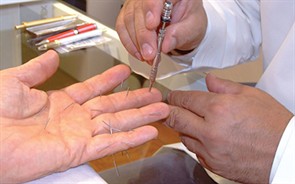Patients seeking acupuncture might be confused when they see advertising for different “styles” of acupuncture such as  Korean acupuncture, Japanese-style acupuncture, or traditional Chinese acupuncture.
Korean acupuncture, Japanese-style acupuncture, or traditional Chinese acupuncture.
What is the difference? Are they all effective?
“Japanese, Korean and Chinese acupuncture all have their foundations in traditional Chinese medicine, and all are very effective,” says Dr. Yihyun Kwon, assistant dean for acupuncture and oriental medicine at National University of Health Sciences. “How acupuncture evolved in different regions of Asia reflects the culture and history of each region.”
Chinese Acupuncture
The acupuncture profession looks to China as the standard traditional model. In China, acupuncturists use big needles with a greater depth of insertion. They are trying to stimulate what is called the “De Qi” sensation, or “arrival of Qi” – life energy flowing through the body. A Chinese acupuncturist will try to enhance that sensation by gently rotating the needle. On a microscopic level, the surface of a Chinese needle is very rough, so patients will definitely feel the needle when is inserted. This heightens the De Qi response.
“Current research shows that the De Qi sensation is really important,” says Dr. Kwon. “There is a better outcome after treatment.”
The Chinese also use more needles, and insert them into a wider area of the body.
Taiwan also has a unique acupuncture system as well, called “Tung” acupuncture. It uses a completely different system with different points. The majority of points are closely located to bones, joints and nerves. The Tung system provides excellent and quick results for patients with musculoskeletal conditions.
Japanese Acupuncture
“The Japanese use thinner needles, and a gentler technique with shallow insertion. Their diagnostic assessment relies heavily on palpation of the abdomen, back and various pulses along the meridian system. In fact, Japanese style acupuncture is often called ‘meridian acupuncture’ for this reason,” says Dr. Hyundo Kim, chief clinician for the acupuncture program at NUHS.
Western medicine moved into Japan much earlier than it did in other Asian countries through Dutch influence in the 1600s. Because of this, Japan has always had more of an interest in western medicine than oriental medicine. Japan even prohibited oriental medicine under Emperor Meiji in the late 1800s. Later on, acupuncture was finally allowed once again, but only as an occupation for the blind.
“This is why their style developed diagnostic methods that relied on palpation rather than sight – feeling the abdomen, back and meridian pulses rather than looking at visual characteristics of the tongue, eyes or fingernails,” says Dr. Kim. “This is also why they use a lot of acupressure as well, as this technique was very adaptable to blind practitioners.”
Korean Acupuncture
Diagnosis in Korean acupuncture is focused on a full constitutional analysis, an old concept rooted in Chinese medicine. A constitutional diagnosis requires a completely separate book of prescriptions. Korean acupuncture also focuses on the extremities like the hand or ear.
Most of the standard acupuncture layouts in Korea use only four needles. In fact, Korean acupuncture is often called ‘four-needle’ technique, or Sa-am technique for this reason.
“The four needles are split two and two – two needles sedate or reduce excess Qi in one organ system, while two other needles tonify or increase Qi in a second organ system,” explains Dr. Kwon. “This balancing concept is the foundation behind four-needle acupuncture.”
“Even though China and Korea border each other, their scholars did not always communicate. That’s why their acupuncture and oriental medical practices differ slightly. Also, some herbs used in Chinese medicine cannot grow in Korea’s climate. Many of the Korean herbal medicine formulas will thus add or substitute herbs that have similar effects but are more common in the Korean climate.”
National’s Approach
“Here at NUHS, our foundation is rooted in traditional Chinese medicine (TCM), as all major styles are. While we provide a strong basis in TCM, we also give our students a taste of these other styles so that later, if they choose, they can go deeper on their own according to their interests,” says Dr. Hyundo Kim. “We also offer in-depth post-graduate courses in more focused styles of acupuncture, such as Korean hand acupuncture technique.”
You can explore more about acupuncture at an NUHS Student for a Day event, and experience a class in the acupuncture program. Or learn more about starting a career with a degree in acupuncture or oriental medicine.
For an appointment with an NUHS acupuncture and oriental medicine clinician, call 630-629-9664.



0 Comments